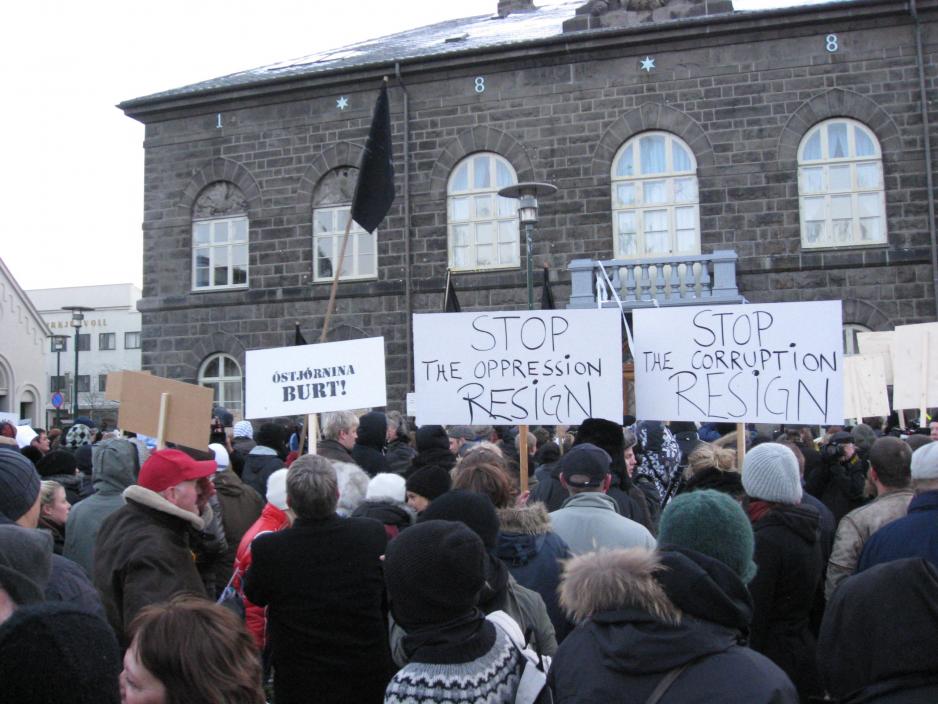Iceland’s Road from Crisis to Recovery

"In response to the severest economic crisis we have seen since independence in 1944, Iceland has introduced a series of unconventional measures to bring the country back on track", says Lilja Alfredsdóttir, former Minister of Foreign Affairs and External Trade of Iceland.
However, the country is still facing a number of severe challenges, ranging from new financial overheating at home and financial and geopolitical risks from abroad.
Second highest losses in history
The financial crisis that hit Iceland in 2008 was extraordinary in many ways, especially for a small country like Iceland with only 338,000 inhabitants, Ms. Alfredsdóttir explained in a presentation titled "Iceland’s Road to Recovery" at the Nordic Embassies in Berlin last month.
The aggregated losses of the Icelandic banks amount to the second biggest recorded in recent history, only after the massive crash of the Lehman Brothers bank in 2008.
For Iceland, this meant in October 2008 that the major banks of the country collapsed, representing 88 percent of the banking system in asset terms, her presentation outlines. This situation was even worsened in a second wave in March 2009 when up to 97 percent of bank assets broke down.
This was accompanied by huge financial losses for many people, and an unemployment rate jumping from 1 percent to 10 percent.
"Iceland’s foreign currency reserves dried up; at one point the country only had three weeks of money left", reminded the Icelandic Ambassador to Germany H.E. Martin Eyjólfsson in his introduction of the event.
Unconventional measures
To respond to such a shock, Iceland introduced a number of rather unconventional measures, Ms. Alfredsdóttir, a former Central Banker and current member of the Icelandic Parliament (Althingi), explained. Since it was obvious that the private banks could not be saved, the decision was taken to protect at least the federal bank and to prevent the socialization of private sector losses.
As part of a first rescue mission, the Central Bank took over the operations of the private banks to split them into domestic and foreign operations. Further, capital controls were introduced to help stabilize the exchange rate after the currency had fallen more than 50 percent in 2008, Ms. Alfredsdóttir, who was at the Central Bank of Iceland during the crisis in 2008, elaborated.
Second Wave of Actions
After the first rescue steps were taken, Iceland entered an in the end very successful cooperation with The International Monetary Fund (IMF), which included a $2.1 billion loan deal. Next, the country had to address the huge large debt accumulated by government and corporate actors as well as private households, which according to Ms. Alfredsdóttir was successfully achieved.
Optimism until 2007
At first sight, the 2008 crash looks rather surprising since Iceland’s position looked very favourably right before the crisis hit.
"Iceland indeed saw a boom like no other", Ms. Alfredsdóttir reminded the audience. In 2007 Iceland had an economic growth of 9.5 percent, the net government debt was next to zero, there was a 5 percent fiscal surplus, the banks were well capitalized, and the country had strong institutions and a highly qualified labour force.
Banking Bubble
This, however, also meant that rating agencies provided Iceland with AAA ratings, which meant strong capital inflow to the country because of abundant cheap credit. This, according to Ms. Alfredsdóttir, lead to an unsustainable banking system, which grew to 10 times the size of the country’s GDP! The results were tremendous economic imbalances, causing immense capital outflow pressures and a significant depreciation of the small, illiquid Icelandic kroner.
Recovery
"Despite these immense tasks for a small economy, thanks to the measures taken, Iceland today is back on its feet", Ms. Alfredsdóttir could report. Gross Domestic Product (GDP) is back to a robust growth of 7.2 percent, inflation is on a low 1.6 percent level, and the unemployment rate is down to 3.2 percent.
A specific boom sector has been the tourism industry, which has seen a 40 percent growth since 1990 or from 500.000 to 1.8 million, increasing Iceland’s foreign reserves.
Ms. Alfredsdóttir also pointed out that while the Icelandic measures were surely very important for the recovery, also external conditions have helped. Low oil prices and favourable commodity prices – for example for fish, one of Iceland’s main export goods – and the increasing international acceptance of unconventional measures, such as capital controls, were relevant factors.
"The most important current number is, however, that Iceland ranks 23 in the FIFA ranking", Ms. Alfredsdóttir added when introducing the key statistics where Iceland stands today, referring to Iceland’s extraordinary performance during the last UEFA European Championship.
Key lessons
Among the key lessons from the crisis that Ms. Alfredsdóttir shared was that small countries cannot sustain a large international banking system, and that capital flow management is important for a small open economy like Iceland. Further, once a crisis hits, capital controls are recommendable to provide a vital breathing space, since it is also necessary to take sufficient time for analysis of the situation in order to decide what the rights steps are that need to be taken, although the crisis situation of course also comes with urgency to act.
Challenges still abound
In her final words, Ms. Alfredsdóttir cautioned that Iceland is still facing a number of serious challenges despite the numbers looking rather good again today. First, there is the risk of a renewed overheating of the economy, for example driven by the booming tourism sector. Iceland is considering measures to prevent such a development, Ms. Alfredsdóttir said.
The lack of societal trust in political parties and politicians is a further challenge, especially when big important tasks such as capital account liberalization and the restructuring of the banking system are still ongoing. Finally, Ms. Alfredsdóttir reminded that Iceland like anyone else is not shielded from external geopolitical and financial risks.
